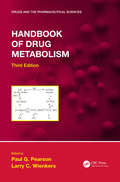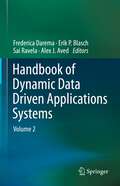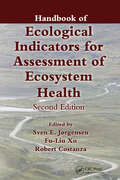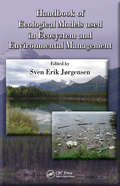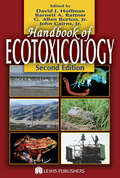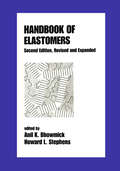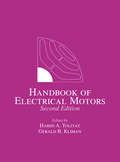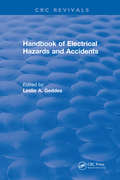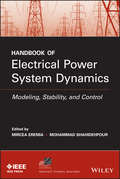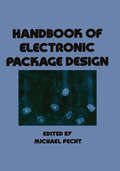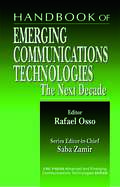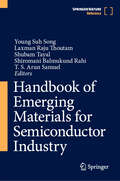- Table View
- List View
Handbook of Drug Metabolism, Third Edition (ISSN #Vol. 186)
by Paul G. Pearson and Larry C. WienkersThis book continues to be the definitive reference on drug metabolism with an emphasis on new scientific and regulatory developments. It has been updated based on developments that have occurred in the last 5 years, with new chapters on large molecules disposition, stereo-selectivity in drug metabolism, drug transporters and metabolic activation of drugs. Some chapters have been prepared by new authors who have emerged as subject area experts in the decade that has passed since publication of the first edition.
Handbook of Drying for Dairy Products
by C. AnandharamakrishnanHandbook of Drying for Dairy Products is a complete guide to the field’s principles and applications, with an emphasis on best practices for the creation and preservation of dairy-based food ingredients. Details the techniques and results of drum drying, spray drying, freeze drying, spray-freeze drying, and hybrid drying Contains the most up-to-date research for optimizing the drying of dairy, as well as computer modelling options Addresses the effect of different drying techniques on the nutritional profile of dairy products Provides essential information for dairy science academics as well as technologists active in the dairy industry
Handbook of Drying of Vegetables and Vegetable Products (Advances in Drying Science and Technology)
by Bhesh Bhandari Min Zhang Zhongxiang FangThis handbook provides a comprehensive overview of the processes and technologies in drying of vegetables and vegetable products. The Handbook of Drying of Vegetables and Vegetable Products discusses various technologies such as hot airflow drying, freeze drying, solar drying, microwave drying, radio frequency drying, infrared radiation drying, ultrasound assisted drying, and smart drying. The book’s chapters are clustered around major themes including drying processes and technologies, drying of specific vegetable products, properties during vegetable drying, and modeling, measurements, packaging & safety. Specifically, the book covers drying of different parts and types of vegetables such as mushrooms and herbs; changes to the properties of pigments, nutrients, and texture during drying process; dried products storage; nondestructive measurement and monitoring of moisture and morphological changes during vegetable drying; novel packaging; and computational fluid dynamics.
Handbook of Dynamic Data Driven Applications Systems: Volume 2
by Sai Ravela Frederica Darema Erik P. Blasch Alex J. AvedThis Second Volume in the series Handbook of Dynamic Data Driven Applications Systems (DDDAS) expands the scope of the methods and the application areas presented in the first Volume and aims to provide additional and extended content of the increasing set of science and engineering advances for new capabilities enabled through DDDAS. The methods and examples of breakthroughs presented in the book series capture the DDDAS paradigm and its scientific and technological impact and benefits. The DDDAS paradigm and the ensuing DDDAS-based frameworks for systems’ analysis and design have been shown to engender new and advanced capabilities for understanding, analysis, and management of engineered, natural, and societal systems (“applications systems”), and for the commensurate wide set of scientific and engineering fields and applications, as well as foundational areas. The DDDAS book series aims to be a reference source of many of the important research and development efforts conducted under the rubric of DDDAS, and to also inspire the broader communities of researchers and developers about the potential in their respective areas of interest, of the application and the exploitation of the DDDAS paradigm and the ensuing frameworks, through the examples and case studies presented, either within their own field or other fields of study. As in the first volume, the chapters in this book reflect research work conducted over the years starting in the 1990’s to the present. Here, the theory and application content are considered for:Foundational MethodsMaterials SystemsStructural SystemsEnergy SystemsEnvironmental Systems: Domain Assessment & Adverse Conditions/WildfiresSurveillance SystemsSpace Awareness SystemsHealthcare SystemsDecision Support SystemsCyber Security SystemsDesign of Computer Systems The readers of this book series will benefit from DDDAS theory advances such as object estimation, information fusion, and sensor management. The increased interest in Artificial Intelligence (AI), Machine Learning and Neural Networks (NN) provides opportunities for DDDAS-based methods to show the key role DDDAS plays in enabling AI capabilities; address challenges that ML-alone does not, and also show how ML in combination with DDDAS-based methods can deliver the advanced capabilities sought; likewise, infusion of DDDAS-like approaches in NN-methods strengthens such methods. Moreover, the “DDDAS-based Digital Twin” or “Dynamic Digital Twin”, goes beyond the traditional DT notion where the model and the physical system are viewed side-by-side in a static way, to a paradigm where the model dynamically interacts with the physical system through its instrumentation, (per the DDDAS feed-back control loop between model and instrumentation).
Handbook of EPR Spectra from Quinones and Quinols
by Jens A. PedersenThis handbook contains a complication of Electron Paramagnetic Resonance (EPR) data of numerous semiquinones and related radicals. The handbook is intended as a general reference guide to the structural studies of the radicals obtained by redox processes from natural and synthetic quinones and quinols.
Handbook of Ecological Indicators for Assessment of Ecosystem Health
by Sven E. Jørgensen; Fu-Liu Xu; Robert CostanzaContinuing in the tradition of its bestselling predecessor, the Handbook of Ecological Indicators for Assessment of Ecosystem Health, Second Edition brings together world-class editors and contributors who have been at the forefront of ecosystem health assessment research for decades, to provide a sound approach to environmental management and sust
Handbook of Ecological Models used in Ecosystem and Environmental Management (Applied Ecology and Environmental Management)
by Sven Erik JørgensenIt is estimated that roughly 1000 new ecological and environmental models join the ranks of the scientific literature each year. The international peer-reviewed literature reports some 20,000 new models spanning the period from 1970-2010. Just to keep abreast of the field it is necessary to design a handbook of models that doesn't merely list them,
Handbook of Ecosystem Theories and Management
by F. Müller S. E. JørgensenAs part of the Environmental and Ecological Modeling Handbooks series, the Handbook of Ecosystem Theories and Management provides a comprehensive overview of ecosystem theory and the tools - ecological engineering, ecological modeling, ecotoxicology and ecological economics -to manage these systems. The book is laid out to provide a summary or
Handbook of Ecotoxicology
by John Cairns Barnett A. Rattner David J. Hoffman G. Allen BurtonCompletely revised and updated with 18 new chapters, this second edition includes contributions from over 75 international experts. Also, a Technical Review Board reviewed all manuscripts for accuracy and currency. Focusing on toxic substance and how they affect the ecosystems worldwide, the book presents methods for quantifying and measuring ecotoxicological effects in the field and in the lab, as well as methods for estimating, predicting, and modeling in ecotoxicology studies. This is the definitive reference for students, researchers, consultants, and other professionals in the environmental sciences, toxicology, chemistry, biology, and ecology - in academia, industry, and government.
Handbook of Egg Science and Technology
by Yoshinori Mine Hajime Hatta Vincent Guyonnet Françoise Nau Ning QiuEggs are one of the most popular foods worldwide due to their great taste and versatility, economical value and high nutritional content. The egg plays an important role in the human diet, both for the nutritional value of its many components (e.g., proteins, vitamins, minerals, choline, specific long chain fatty acids) as well for its wide range of functional characteristics, including foaming, gelling and emulsifying properties. The egg sector is a vibrant field with many new developments in terms of production, processing and commercialization as well as research. Since the beginning of the 21st century, the global production of eggs has grown by 69.5%, farm production systems have evolved to improve the welfare of laying hens, many eggshell and egg products have been developed to address the changing demands of consumers and our knowledge of the composition of the egg has been boosted by the latest gene-based technologies. Information on the science and technology of egg and egg processing is essential to governments, academia and industry. The Handbook of Egg Science and Technology aims to be the first book providing a complete source of information about egg science and technology, covering topics such as world egg production, marketing of eggs, chemistry of egg components, functional properties of egg components, egg processing, egg product development, eggshell quality, grading, egg microbiology, egg pasteurization, egg nutrition and bioactive components, egg biotechnology and sustainability of egg production. Features Includes the most current and comprehensive scientific and technical information about egg science and technology Presents an ideal guide for professionals in related food industries, egg business consultants, regulatory agencies and research groups Answers the need for a comprehensive textbook for upper-level undergraduate and graduate courses in food science, animal science and poultry departments A global panel of experts in the field of egg science was gathered with the aim to provide the most updated information and development on many topics likely to interest readers ranging from academia and food science students to managers working in the food production and egg processing sectors. This handbook is an excellent resource for the food and poultry industry, R&D sectors, as well as experts in the field of food and nutrition.
Handbook of Elastomers (Plastics Engineering)
by Anil K. Bhowmick Howard L. StephensProvides the latest authoritative research on the developments, technology, and applications of rubbery materials. Presents structures, manufacturing techniques, and processing details for natural and synthetic rubbers, rubber-blends, rubber composites, and thermoplastic elastomers. 80% revised and rewritten material covers major advances since publication of the previous edition.
Handbook of Electric Motors
by Hamid A. Toliyat Gerald B. KlimanPresenting current issues in electric motor design, installation, application, and performance, this second edition serves as the most authoritative and reliable guide to electric motor utilization and assessment in the commercial and industrial sectors. Covering topics ranging from motor energy and efficiency to computer-aided design and equipment selection, this reference assists professionals in all aspects of electric motor maintenance, repair, and optimization. It has been expanded by more than 40 percent to explore the most influential technologies in the field including electronic controls, superconducting generators, recent analytical tools, new computing capabilities, and special purpose motors.
Handbook of Electrical Engineering Calculations (Electrical and Computer Engineering #Vol. 106)
by Arun G. PhadkeWritten by experienced teachers and recognized experts in electrical engineering, Handbook of Electrical Engineering Calculations identifies and solves the seminal problems with numerical techniques for the principal branches of the field -- electric power, electromagnetic fields, signal analysis, communication systems, control systems, and computer engineering. It covers electric power engineering, electromagnetics, algorithms used in signal analysis, communication systems, algorithms used in control systems, and computer engineering. Illustrated with detailed equations, helpful drawings, and easy-to-understand tables, the book serves as a practical, on-the-job reference.
Handbook of Electrical Hazards and Accidents
by Leslie A. GeddesThis book is written mainly for attorneys, physicians, and investigators who are concerned with accidents associated with electric current. It is based on approximately 50 years of personal research, augmented by experience in teaching medical and biomedical engineering students and as an expert witness in litigation involving electrical injury. The material is presented in two ways: non-technically, for attorneys and physicians, and technically, for their expert witnesses and engineers. Since there is no typical electrical accident, the accidents described and the material presented in the chapters are selected to aid the reader in explaining the cause of any particular electrical accident.
Handbook of Electrical Power System Dynamics: Modeling, Stability, and Control (IEEE Press Series on Power Engineering #92)
by Mohammad Shahidehpour Mircea EremiaThis book aims to provide insights on new trends in power systems operation and control and to present, in detail, analysis methods of the power system behavior (mainly its dynamics) as well as the mathematical models for the main components of power plants and the control systems implemented in dispatch centers. Particularly, evaluation methods for rotor angle stability and voltage stability as well as control mechanism of the frequency and voltage are described. Illustrative examples and graphical representations help readers across many disciplines acquire ample knowledge on the respective subjects.
Handbook of Electroluminescent Materials (Series in Optics and Optoelectronics)
by D. R. VijAn electroluminescent (EL) material is one that emits electromagnetic (EM) radiation in the visible or near visible range when an electric field is applied to it. EL materials have a vast array of applications in the illumination and displays industries, from cheap and energy efficient lighting to large high resolution flat panel displays.
Handbook of Electronic Package Design (Mechanical Engineering #76)
by Michael PechtBoth a handbook for practitioners and a text for use in teaching electronic packaging concepts, guidelines, and techniques. The treatment begins with an overview of the electronics design process and proceeds to examine the levels of electronic packaging and the fundamental issues in the development
Handbook of Electronic and Digital Acquisitions
by Thomas W LeonhardtEverything you need to know about adding e-resources to your library's servicesHandbook of Electronic and Digital Acquisitions steers librarians through the process of evaluating, choosing, and managing electronic resources as they expand their collection development policies to include electronic databases. This handy, how-to guide takes a practic
Handbook of Electroporation
by Damijan MiklavčičThis major reference work is a one-shot knowledge base on electroporation and the use of pulsed electric fields of high intensity and their use in biology, medicine, biotechnology, and food and environmental technologies. The Handbook offers a widespread and well-structured compilation of 156 chapters ranging from the foundations to applications in industry and hospital. It is edited and written by most prominent researchers in the field. With regular updates and growing in its volume it is suitable for academic readers and researchers regardless of their disciplinary expertise, and will also be accessible to students and serious general readers. The Handbook's 276 authors have established scholarly credentials and come from a wide range of disciplines. This is crucially important in a highly interdisciplinary field of electroporation and the use of pulsed electric fields of high intensity and its applications in different fields from medicine, biology, food processing, agriculture, process engineering, energy and environment. An Editorial Board of distinguished scholars from across the world has selected and reviewed the various chapters to ensure the highest quality of this Handbook.The book was edited by an international team of Section Editors: P. Thomas Vernier, Boris Rubinsky, Juergen Kolb, Damijan Miklavcic, Marie-Pierre Rols, Javier Raso, Richard Heller, Gregor Serša, Dietrich Knorr, and Eugene Vorobiev.
Handbook of Electrostatic Processes
by Jen-Shih Chang Arnold J. Kelly Joseph M. Crowley"Provides detailed, comprehensive descriptions of electrostatic processes as well as their applications in areas such as rheology, atomization and spraying, industrial dust particle precipitation and filtering, biomedical engineering, gas treatments, atmospheric electricity, chemical reactors, and electronic devices. Summarizes electrostatic fundamentals and electrical phenomena in solids and fluids."
Handbook of Emergency Management Concepts: A Step-by-Step Approach
by Michael L. MadiganThis book provides a step-by-step process that focuses on how to develop, practice, and maintain emergency plans that reflect what must be done before, during, and after a disaster, in order to protect people and property. The communities who preplan and mitigate prior to any incident will be better prepared for emergency scenarios. This book will assist those with the tools to address all phases of emergency management. It covers everything from the social and environmental processes that generate hazards, to vulnerability analysis, hazard mitigation, emergency response, and disaster recovery.
Handbook of Emergency Response: A Human Factors and Systems Engineering Approach (Environmental and Occupational Health Series #27)
by Adedeji B. Badiru Leeann RaczDespite preemptive preparations, disasters can and do occur. Whether natural disasters, catastrophic accidents, or terrorist attacks, the risk cannot be completely eliminated. A carefully prepared response is your best defense. Handbook of Emergency Response: A Human Factors and Systems Engineering Approach presents practical advice and guidelines
Handbook of Emergency Response: A Human Factors and Systems Engineering Approach, Second Edition (Environmental and Occupational Health Series)
by LeeAnn Racz and Adedeji B. BadiruDespite pre-emptive preparations, disasters can and do occur and are a fact of life. Whether natural disasters, catastrophic accidents, or terrorist attacks, the risk cannot be completely eliminated. A carefully prepared response is your best defense. This fully updated second edition of the Handbook of Emergency Response presents practical advice and guidelines on how to plan the coordinated execution of emergency response.This handbook incorporates human factors and a systems engineering approach to emergency response project management. It provides cutting-edge research in developing a systematic structure for communication, cooperation, and coordination. Managing a project in the wake of a tragedy is complicated and involves various emotional, sentimental, reactive, and chaotic responses. This is the time when a structured communication model is most needed. This second edition includes important lessons learned and developments since the first edition was published, as well as additional information devoted to systems thinking and industrial engineering in planning for responses to emergencies. The reader will develop a thorough understanding of how to handle an emergency response using a systems approach.The handbook is an ideal purchase for any student or practitioner of human factors, safety, systems engineering, events management, local or federal governance, or those in the emergency services.
Handbook of Emerging Communications Technologies: The Next Decade (Advanced & Emerging Communications Technologies)
by Rafael OssoCommunication technologies change the way we live our lives-the ways we communicate and share information, the news, and our entertainment. The new millennium promises to bring some of the most volatile activity in the history of communications, as we continue to be bombarded by new standards and technologies. The near frenzy of corporate mergers and acquisitions accelerates technological development and can provide hints of what is to come. With the rapid appearance of new protocols, standards, and tools, it becomes increasingly difficult -and increasingly important-for communications professionals to remain up-to-date on new and emerging technologies.The Handbook of Emerging Communications Technologies: The Next Decade fills this gap. Until now, information on many of its topics, such as Multiprotocol over ATM, IP Multicasting, and RSVP, existed only as fragmented articles on the Internet or as complex feature specifications. In this landmark volume, 18 leading authorities each tackle one of the cutting edge technologies destined to shape the future. Each chapterDescribes a technology and any standards on which it is based Discusses its impact on the communications field Forecasts its future directionDeveloped primarily for telecommunications specialists network managers, developers, and analysts, the Handbook of Emerging Communications Technologies: The Next Decade, offers the opportunity to acquire a deeper understanding of future technologies necessary to remaining current, and serves as a valuable reference guide for corporate executives, planners, and information managers-anyone seeking general knowledge about where the communications industry is heading.
Handbook of Emerging Materials for Semiconductor Industry
by Laxman Raju Thoutam Shiromani Balmukund Rahi Young Suh Song Shubam Tayal T. S. Arun SamuelThe proposed book will be a “one-stop” place for all the young material researchers to understand the recent and reliable material making process, characterization, and reliability test tools. The proposed book is designed to provide basic knowledge to understand and analyse structure-property relationship for reliable emerging material systems for next generation of semiconductor technologies.The book is suggested to engineers and scientists across the world working on various new and novel materials for reliable semiconductor device applications. The book is expected to serve as a reference guide for young scientists and engineers in the field of material science and electronic engineers to acquire latest state-of-art experimental and computational tools to encourage their research activities.Since the scope of the book is generic, the book can be referred by all the students of science and engineering students to create a common awareness about the latest material systems and state-of-art characterization tools that have been broadly utilized to study the physical and chemical properties of different material systems.It introduces the readers to a wide variety of new emerging materials systems including their synthesis, fabrication, measurement, reliability test, modelling and simulations with in-depth analysis of selective applications.This book contains the state-of-art research updates in the various fields of semiconductor, artificial intelligence (AI), bio-sensor, biotechnology, with respect to reliable material research. Therefore, various students who are eager to get a job in semiconductor/AI/Autonomous car/biotechnology are strongly recommended to read this book and learn about related state-of-art knowledge.
